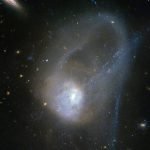Space & Future
A year that mattered: Caltech’s scientific journey in 2025
Caltech is a place unlike any other, an Institute that is truly "small but mighty."
Its small size and the expertise of its community enable...
The Milky Way had a wild past, and Webb is finally revealing it
How did the Milky Way become the calm, spiral galaxy we see today?
New observations from the James Webb Space Telescope (JWST) suggest that our...
Gaia space telescope spots possible planets forming around baby stars
How do planets like Earth and Jupiter come into existence?
Astronomers are beginning to answer that question thanks to new observations from the European Space...
NASA’s Perseverance Rover is ready for many more miles—and new discoveries on Mars
After nearly five years on Mars, NASA’s Perseverance rover is proving it was built to last.
Since landing in February 2021, the six-wheeled robot has...
Astronomers witness a violent space collision around a nearby star
Astronomers have captured something extraordinary: the aftermath of a violent collision between large space rocks in another planetary system.
Using NASA’s Hubble Space Telescope, scientists...
This shape-shifting wheel could help robots explore the moon’s hidden caves
Exploring the Moon’s surface is challenging enough, but reaching what lies beneath it is even harder.
Deep pits and long lava tubes on the Moon...
Why Saturn’s moon Titan might be less oceanic—and more complex—than thought
For years, scientists believed that Titan, Saturn’s largest moon, hid a vast ocean of liquid water beneath its thick, icy shell.
This idea made Titan...
Why most exoplanets are magma worlds
In astronomy, there is a concept called “degeneracy”.
It has nothing to do with delinquent people, but instead is used to describe data that could...
The first alien civilization we encounter will be extremely loud
For decades, science fiction writers have tried their best to prepare us for eventual contact with aliens. Their efforts are dominated by several recurrent...
Scientists find a crack in a 50-year-old law of the universe
Astronomers may have uncovered evidence that challenges one of the longest-standing ideas about quasars, the brilliant beacons powered by supermassive black holes.
A new international...
Webb finds signs of a thick atmosphere on an ultra-hot super-Earth
Astronomers using NASA’s James Webb Space Telescope have found the strongest evidence yet that a rocky planet outside our solar system can hold on...
Scientists challenge the idea that every galaxy has a black hole
A new study using NASA’s Chandra X-ray Observatory suggests that many small galaxies may not contain supermassive black holes at their centers after all.
This...
Deep Space
Tiny galaxies prove dark matter is real, defying modified gravity theories
A new international study has provided one of the clearest signs yet that dark matter—not a change in gravity—is responsible for the mysterious way...
Black holes need refreshing cold gas to keep growing
The Universe is filled with supermassive black holes.
Almost every galaxy in the cosmos has one, and they are the most well-studied black holes by...
New comets study reveals chemical composition of early solar system
A new study by University of Central Florida researchers has found strong evidence that the outgassing of molecules from comets could trace the chemical...
The first close-up picture of star outside the Milky Way
Like a performer preparing for their big finale, a distant star is shedding its outer layers and preparing to explode as a supernova.
Astronomers have...
Astronauts are going to check if there are microbes on the outside of the...
On Thursday January 30th, astronauts Suni Williams and Butch Wilmore are doing a 6.5-hour spacewalk outside the International Space Station.
Among other goals, they’ll be...





















